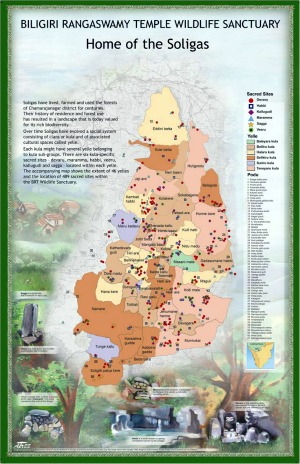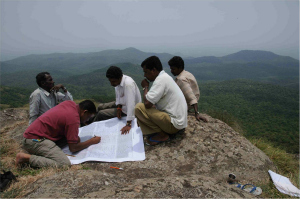Guest Post: Nitin Rai, Ashoka Trust for Research in Ecology and the Environment (ATREE)
Drawing upon his experience working with the Soligas who live within the Biligiri Rangaswamy Temple Wildlife Sanctuary, Nitin Rai talks about the ‘wilderness’ myth and explores the origins and impacts of the belief that people and animals cannot co-exist.

The myth of the Protected Area
The trend: The last three decades have seen a surge in protected areas, both globally and nationally. In 2009, there were approximately 70,000 protected areas covering a total of 18 million square kilometres in the world. In India, this surge is linked with the Wild Life Protection Act of 1972. At the turn of the century, there were 623 protected areas in the country covering approximately 4% of the land area.
The results:
However, has this had the expected results? Studies indicate otherwise suggesting that global biodiversity trend is inversely proportional to the areas protected*. In India, after the initiation of Project Tiger- an exercise involving the deployment of many jeeps and guns and much displacement- the number of tigers increased steadily till 1989. Studies have shown that the increase might be attributed to the over –zealousness of the forest administration in inflating tiger numbers to please political powers. With the decrease in direct political interest in tiger conservation, and through the repeated exposure of attempts at falsication, it was clear that tiger numbers had only marginally increased over the last foru decades of project tiger. This illustrates the inadequacy of Project Tiger.
The reasons:
Despite these figures, the continuing trend of declaring protected areas indicates that species conservation is only one of the motivating factors. Certainly, revenue generation is one important motivator. Wildlife tourism is an important source of income both for the State and for private operators. In India, it is also relatively easy to declare an area as ‘protected’. With the exception of the North-East, most forests in India are state-owned, which eases the way for notification of protected areas.
The origins:
Part of our fascination with the notion of ‘protected areas’ stems from our inherited environmental history. Earlier colonial management- preoccupied with the harvesting of timber- identified traditional management practices such as controlled fires as ‘the chief, almost the only enemy’ (Pyne, 1994). This does not take into account the fact that most forests have evolved with fire. Fire is a problem for timber, since the wood is damaged by the flames. However it is crucial for non-timber forest products such as tubers and grasses, which forest-dwellers are dependent on.
The effect:
Since Independence, protected areas have physically displaced 0.6 million people. Forest dwellers were forced out of the mainstream economy in colonial times by being refused rights to land. Thus they were ‘arborealised’ or made dependent on things with little or no market value.
Historically, conservation projects have:
- Produced marginalised communities (landless and ‘arborealised’)
- Erased social and cultural histories
- Elevated levels of poverty
- Altered ecological systems
Biligiri Rangaswamy Temple Wildlife Sanctuary
Earlier a reserved forest, it is now a wildlife sanctuary. It is also home to the Soligas that live within the forest. When the sanctuary was created, Soligas were relocated to the periphery. The exceptions to this relocation were those Soligas that worked on the coffee plantations that existed- and continue to exist- in the heart of the sanctuary. The historical baggage that environmental decisions carry are explicit in the language used in the maps of the area today. Soliga villages are referred to as ‘encroachments’ and appear in maps that show threats to the wildlife sanctuary. What this means is that tribal forest dwellers are not allowed to continue their traditional mode of life, but only ‘allowed’ where they are needed to serve corporate interests.
 Mapping the Soliga’s lands
Mapping the Soliga’s landsRecognizing that existing maps did not recognise the Soliga view of the land, ATREE and the Soliga Abhivriddhi Sangha began mapping cultural sites. 489 sites belonging to six different Soliga clans were mapped in 18 months. These clans have well defined areas that belong to them. These areas are described orally, but so explicitly that a person displaced 40 years ago can still identify them today. Despite our concerns that the transformation of an oral history to a printed map could sow the seeds of conflict among the clans, the Soligas themselves saw enormous benefit in this mapping. At their request, maps have now been put up in the schools and distributed to the villages.
Threats to the Soligas
Despite being relocated when the sanctuary was created, the Soligas could still harvest non-timber forest produce (NTFP). This changed in 2006 when the collection of forest produce was banned. Since 62% of a Soliga family’s income is dependent on NTFP, this ban hit them hard. The Soligas protested, but to no avail. In 2011, the Forest Department without following due process declared BRT as a Tiger Reserve. The existing conservation policy does not mandate consultation with forest dwellers before such a declaration, and Soligas only heard about this notification from news reports. The forest department has begun efforts to relocate Soligas from core areas of the reserve by offering them compensation. This will further marginalise these adivasis.
The Soligas and conservation
The denial of livelihood to the Soligas is, as we have seen earlier, due to the assumption that all human interference is a threat to wildlife. However, this does not account for the fact that 34 tigers in the BRT forest area continued to thrive despite the tribal villages. The Soligas claim, with reason, that instead of being a threat to the tigers, adivasi presence in the area actually protects tigers. It is difficult for poachers to enter the forest without the Soligas knowledge.
The single biggest threat to the BRT forest today is Lantana camara, which has grown exponentially since 1997. The Soligas believe that fire controlled the spread of lantana ,and also killed the hemiparasites that are now choking the trees. These low-lying litter fires check the growth of both these invasive species.
However ,with conservation being seen as an ‘expert’ science, and with policies being formed in Delhi, it is impossible for forest officials to implement local ecological knowledge.
The status today
The Forest Rights Act confers individual rights to land being currently cultivated, and community rights that include among others, right to collection of forest resources, and the right to conserve forest resources. On the 2nd of October 2011, 25 gram sabhas were given community rights. During a multi-stakeholder meeting held in July, a collaborative management plan was drawn up which included:
- Ecological conservation
- Livelihoods
- Governance and management.
The Forest department declined to attend this meeting, while the Soligas insist that management is only possible when undertaken jointly. Relocation threatens to divide a close-knit community, and affect livelihoods and cultural identities.. And there is still no guarantee that this move will benefit the tigers of the Biligiri Rangaswamy Temple Wildlife Sanctuary.
* C Mora, PF Sale. Ongoing global biodiversity loss and the need to move beyond protected areas: a review of the technical and practical shortcomings of protected areas on land and sea. Marine Ecology Progress Series, 2011; 434: 251 DOI: 10.3354/meps09214

 Mapping the Soliga’s lands
Mapping the Soliga’s lands